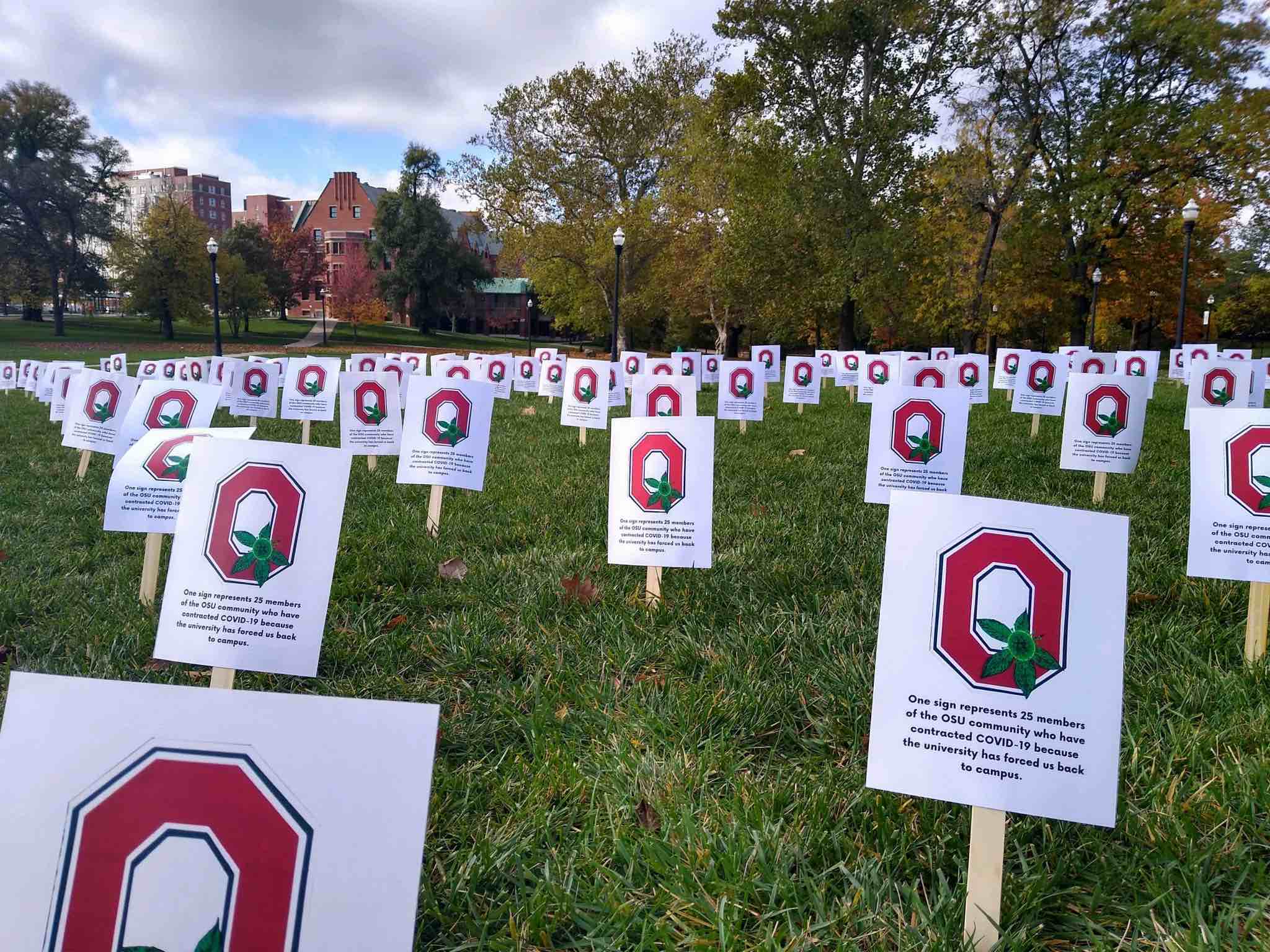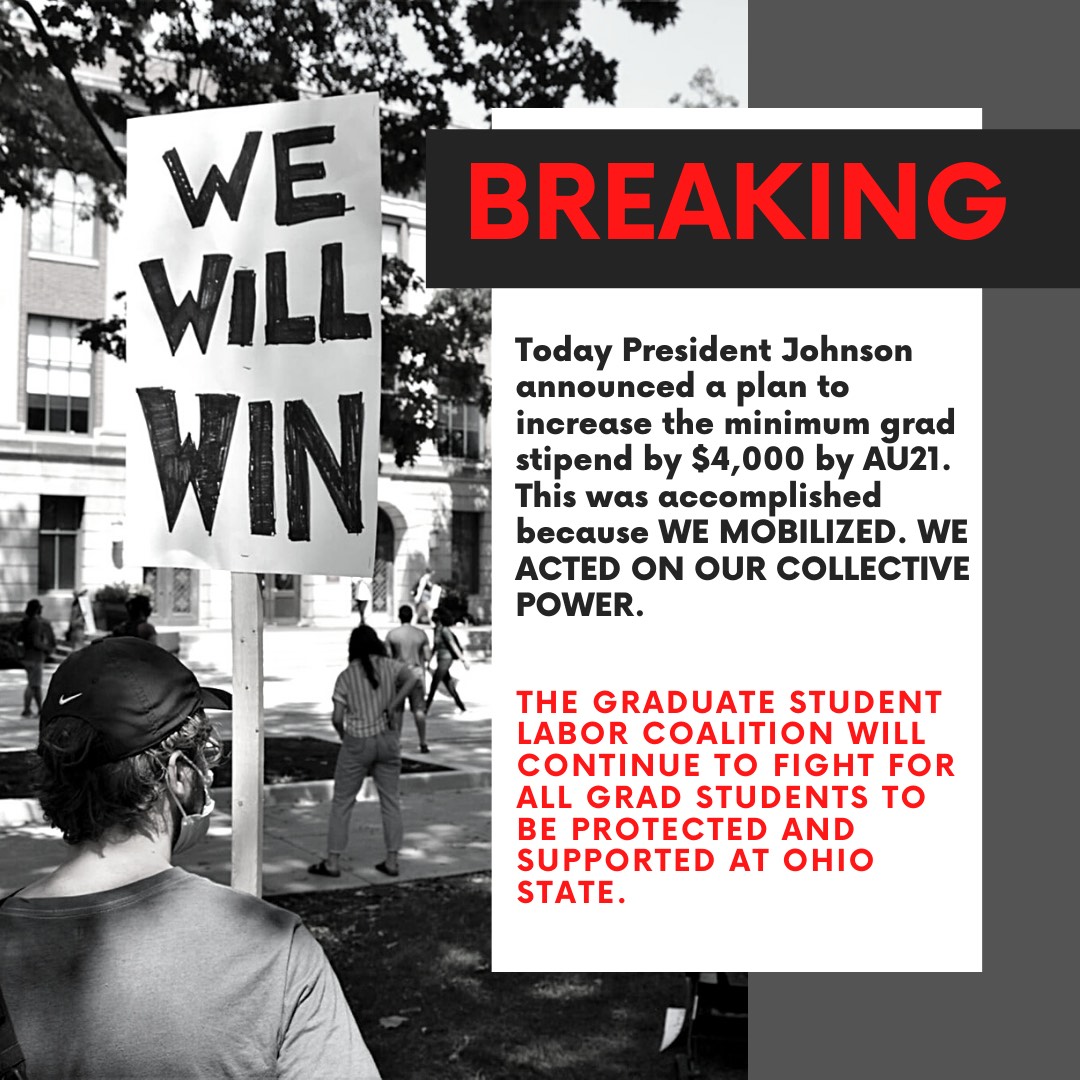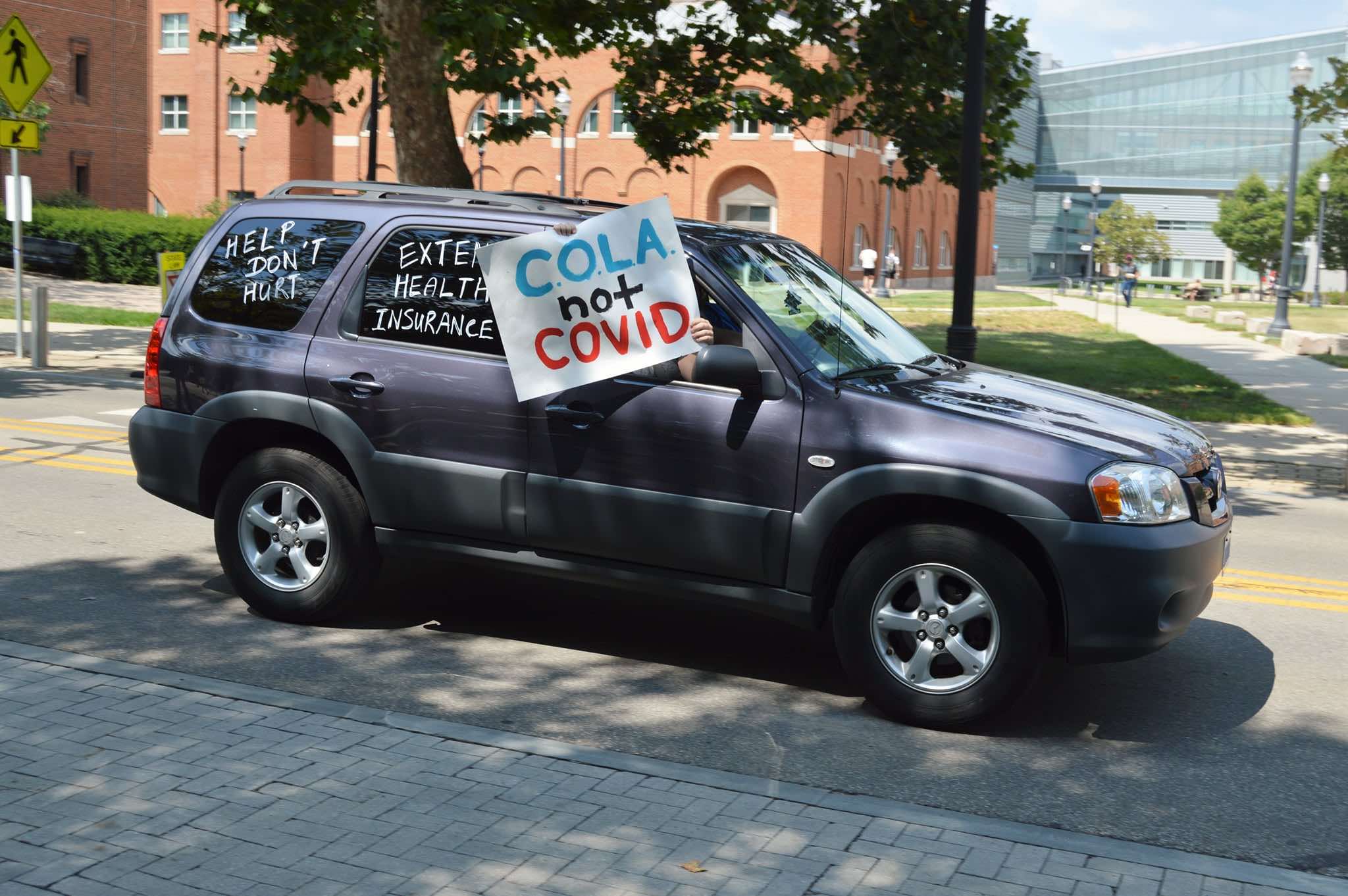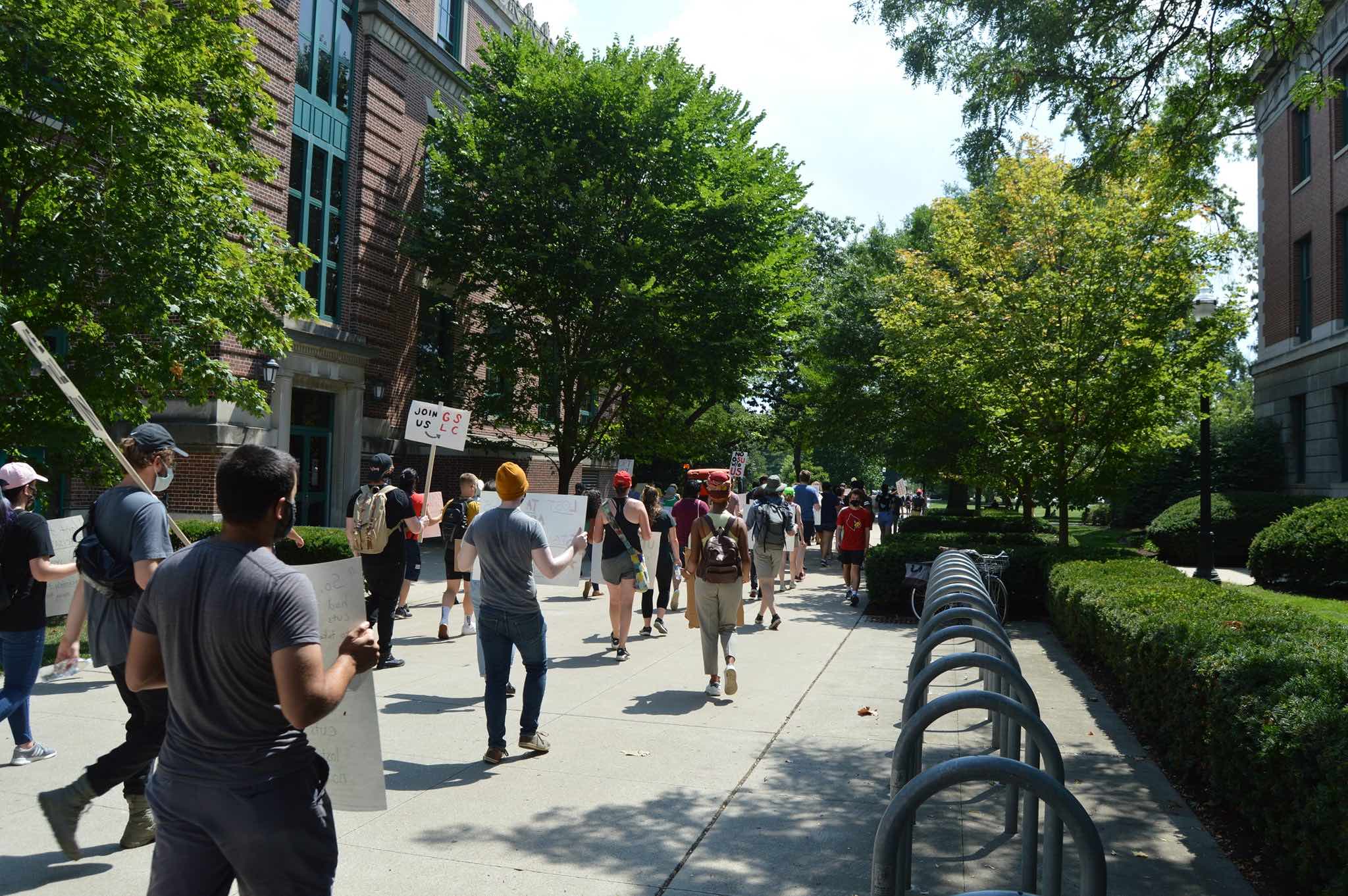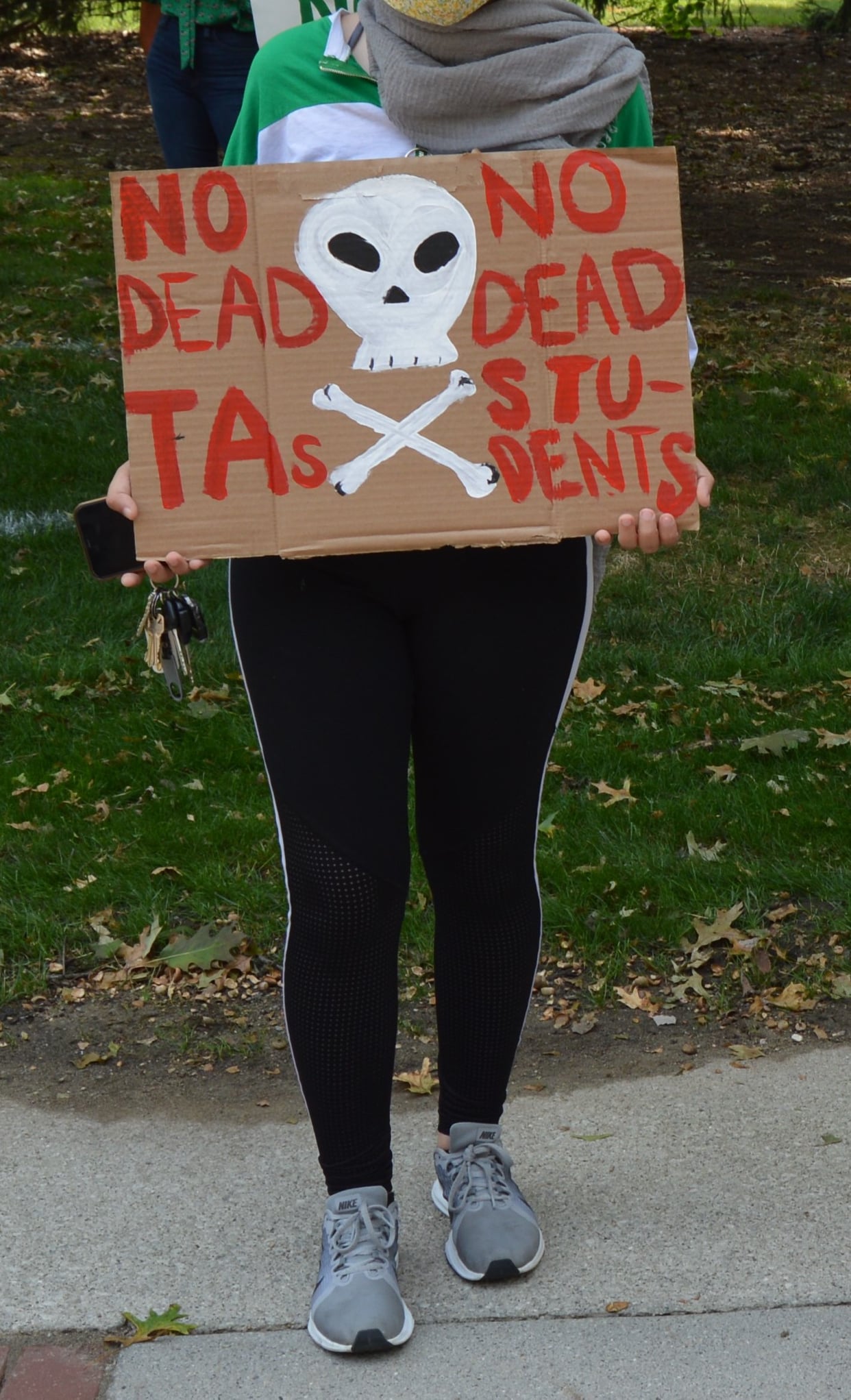Dawn Tefft
Posted December 15, 2023
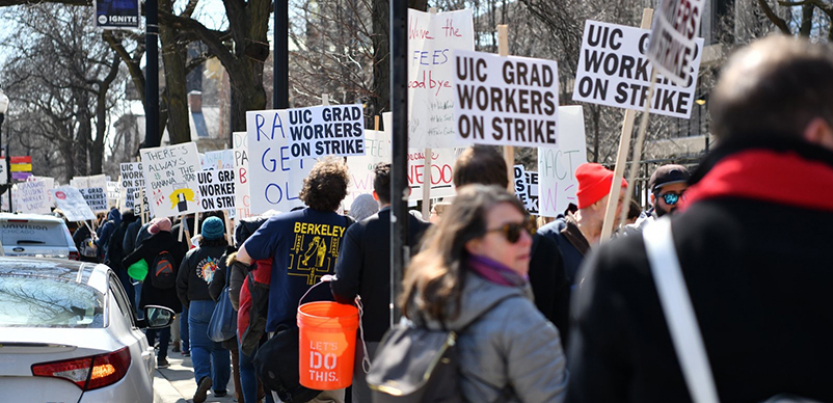
The Emergency Workplace Organizing Committee (EWOC)—which pairs volunteer organizers with workers looking for organizing support—plays a unique role in the labor movement. EWOC was founded by United Electrical Workers and DSA in response to workers needing emergency organizing support during the pandemic. It has since evolved to support workers wanting to organize a new union or an issue campaign in almost any scenario. EWOC was founded with a few principles in mind: 1) volunteers can support and advise workers, but the workers are always in control of the campaign and make their own collective decisions, 2) collective action is often necessary to win a campaign, and 3) EWOC should be a space for anyone who believes in the first two principles, a space where socialists of any tendency as well as people on the broad left who don’t belong to socialist organizations can work together without conflict.
Given how many different types of people volunteer with EWOC, it should come as no surprise that volunteers’ approaches to, and beliefs about, organizing can vary. As a volunteer organizer within EWOC, I don’t pretend to speak on behalf of EWOC, but I can speak about what I see as its potential. One of the main benefits of organizing through EWOC is that workers and volunteers have more room to create bottom-up campaigns that are responsive to workers’ conditions, which in some cases include taking calculated risks.
If one believes that the model popularized by Jane McAlevy is the tried and true method for winning a campaign and that it should always be followed to the letter, then, in my opinion, one has already lost in a number of situations where that model simply doesn’t fit the conditions. In books such as No Short Cuts, McAlevy consistently asserts that workers must form a Contract Action Team (CAT) and that they must treat escalating actions as “structure tests.” The CAT is a group of activists dedicated to helping plan actions and secure commitments from their co-workers to participate in those actions. If each successive action sees increased worker participation over the previous action, and if the participation threshold for the last action before a potential strike is met, then workers will be allowed to go on to strike. McAlevy also asserts that at least 90% of a bargaining unit needs to participate in strike votes and strikes in order to have enough power to win.
While much of what McAlevy proposes can be highly effective, and some strategies are even ideal, one does not need to follow a McAlevian blueprint in order to build power. And there are cases where trying to follow such a blueprint has the potential to cut a campaign short or otherwise undermine the campaign, preventing workers from building as much power as they are capable of in their context, which in many cases might be enough power to win significant gains as well a potential spur to building even greater power down the line. Contrary to following such a model, where workers must do A, B, C, and D to win, if one is willing to share some best practices with workers and then listen carefully to them about their conditions, both learning from them and offering them things to consider in planning their own campaign from start to finish, then one has the potential to provide the kind of context-specific support that can win the day in especially difficult circumstances.
In EWOC, where we tend to take on cases that are especially difficult, this might mean organizing strong minority actions where workers are unable, for whatever reasons, to organize a majority action despite solid efforts at doing so. In a high-turnover workforce, it might mean moving from a card drive to an election with a majority but without a super majority, despite the risk that the union-busting tactics an employer typically employs between a card drive and an election might erode support below the threshold for winning an election. It might mean taking strong actions such as sick outs, work-to-rule actions, etc. during issue campaigns where the workers, despite having been educated about the power of the strike, choose not to strike. It might even mean organizing an independent union, though I believe that in most situations an independent union is not the best route to go, because history has shown that they are rarely able to win strong contracts without the resources and networks of established parent unions. An independent union might be necessary if no parent union is willing to take on the worker unionization campaign, or no parent union is willing to be flexible enough in their approach to accommodate the needs of the worksite.
The Amazon Labor Union: A Model or An Exception?
The Amazon Labor Union—it’s successes and failures—has sparked discussion about organizing in today’s difficult conditions. Some people have argued that ALU, an independent union organized by the workers at Amazon’s Staten Island warehouse known as JFK8, is a beacon for the labor movement. Others have argued that the hope born of ALU’s first, and so far, only victory was entirely misplaced. Both perspectives are too extreme in my opinion. Just because ALU wasn’t able to replicate its formula-eschewing victory at other facilities doesn’t mean the approach they applied at JFK8 wasn’t the right approach for that facility. Maybe it wasn’t the approach best suited for the other facilities, or maybe it was the most fitting approach for them, too, but they simply lacked the type of leadership at those facilities necessary for winning.
It seems short sighted to argue definitively against an approach that won the day at a worksite in an industry where no amount of parent-union-backed drives employing traditional logic had succeeded, just because the next two drives failed. After all, many well-organized traditional drives have failed in this and similarly notoriously difficult-to-organize industries. It also seems short sighted to assume that the approach ALU took is the future of organizing. At the very least, it seems to have been the right approach in many respects for JFK8, whether or not it was the right approach for the other facilities. This isn’t to say that some of the criticisms of ALU aren’t accurate or that ALU shouldn’t be doing some things differently than they are. It’s just to say that they seem to have won that first victory with a bottom-up campaign attentive to their conditions rather than applying a formula and that this was a crucial factor in why they won.
Some Examples from Higher Education Organizing
As an EWOC volunteer I have focused on the needs of the workers and their contexts, helping workers at several large colleges and universities organize issue campaigns of escalating actions that culminated in either a strong majority action or a strong minority action. These campaigns in an industry characterized by contingency and high turnover won major gains without any union staff support on the ground to assist with one-on-ones through worksite visits or house visits, even when the workers numbered in the thousands. I educated organizing committees about how majority actions wield the most power and protection for the workers, but I never foreclosed the possibility of taking strong minority actions where the workers weren’t able to organize a majority action.
I also educated the Organizing Committees about the critical importance of the strike as a tactic, and about how it carries the most leverage of any action. So far, all of them have chosen to take strong actions that weren’t strikes. In some cases, workers faced state laws that make striking in their sector illegal. It is true that workers can and do strike successfully even in states where their strikes are illegal and can carry severe penalties. Still, taking an illegal strike can be very daunting. The workers I was organizing with didn’t feel that striking would be the right fit for their current conditions. I believe they were probably right in deciding that their campaigns would culminate in other types of strong actions, such as a boycott of accepting teaching jobs or a sick out.
As in my volunteer work with EWOC, in my work as a paid union staffer, I’ve also seen how approaching things differently at different sites is often necessary in order to win. For example, the contract campaign training I facilitate educates workers about how locals often form Contract Action Teams (CATs) in order to organize a contract campaign, or else ask the stewards system to take on the work of a CAT. However, one local that I support was unable to get workers to volunteer to be on a CAT or be stewards. In that unit, half or more of the unit often attended General Membership Meetings (GMMs), so I suggested we use the GMM to plan a campaign of escalating actions, and then let folks know that if they wanted the campaign to work, they would need to volunteer to talk to co-workers in their departments. Not only did the members volunteer, they even went on to take a successful strike vote.
For this local’s next contract campaign, they might choose to try again to build a CAT. However, I view the approach we took there to be more highly evolved than a CAT, in that a majority of the bargaining unit accurately views it as their responsibility to talk to their co-workers about the contract campaign. For this reason, personally I would rather they continue that approach than shift to a CAT. If, instead, they try to formalize a CAT structure in that unit, it might work just as well or better, but my fear is that fewer people will volunteer to be part of a standing group and that those who previously talked to co-workers but don’t join the CAT will simply view talking to co-workers as the scope of the CAT.
Another example of deviating from organizing norms comes from my experience supporting workers at the University of Wisconsin who organized a card drive that led to the formation of the only new public sector union to be formed during the eight years that union-busting Scott Walker was governor. Instead of regular Organizing Committee meetings, we held, “drop in” sessions at the University’s campus bar, because the OC members demonstrated that they would come to the bar but not organized meetings. I would let them know I would be at the bar from, say, 12pm-6pm, and they could come by any time to debrief and drop off the signed membership cards. And though my supervisor had instructed me to meet with the workers every two weeks, we actually met every three weeks, because fewer people participated if we held to the standard of meeting every two weeks. When it was critical to do so, we would once again meet as an OC.
Some organizers view OC meetings as tests in the McAlevian sense, deeming a unionization campaign as untenable, if most or all of the OC don’t attend weekly or bi-weekly OC meetings. From my experience, I would say that this is not the best measure of campaign support and potential. At this stage of capitalism, many workers have families and/or multiple jobs, and just incredibly high demands on their time. Not treating OC meetings as tests of sorts was, in my opinion, just as critical to successfully organizing the new union in Wisconsin as was our emphasis on one-on-ones. In those meetings with academic workers who had so many of their rights stripped away by union-busting legislation, we argued that laws don’t confer power on us; rather, power originates in us. We were able to win not by requiring that the activists or the larger group of workers prove themselves, but by creating an organizing environment where workers made informed decisions about how to organize, focusing on structuring the campaign in ways that worked for the largest number of workers.
Different Worksites, Different Approaches
Different kinds of worksites require different organizing approaches. For instance, in a factory signing a petition is often considered a strong action. In higher ed, where academic workers have a lot of autonomy and where political petitions are constantly floating around, a petition is a very low-level action that typically doesn’t do much to build power. Precisely because they have so much freedom, workers in higher ed typically have to take very strong actions, like marches on the boss, strikes, and packing Board of Trustees meetings, in order to move their employer. Having said that, in a higher ed worksite where workers don’t have a history of organizing, a petition might wield a fair amount of power simply because it is an action. Again, context is important.
For similar reasons, I don’t view escalating actions in higher ed as tests. I view them as opportunities for building confidence and hopefully capacity. However, even when the numbers involved don’t increase as actions escalate, I have seen workers still go on to stage a majority strike. This contradicts a McAlevian model, where professional organizers would hold workers back and advise them not to call for a strike, because they hadn’t passed the tests that the previous actions were intended to be. In my experience, in such situations, the workers know that the lower-level actions aren’t going to produce results, and they don’t participate until it’s time for a large-scale action with a lot of leverage, one that they know is worth their time because it’s likely to get results.
Another useful organizing strategy in higher ed and many other industries is to apply concerted pressure in key areas. In higher ed, that might mean aiming for super majorities in the departments that teach Gen Eds—English, Math, Chemistry, and Biology—both because they teach the courses that serve the largest numbers of students and because they have a lot of workers. In many situations, shutting down these key areas alone could exert enough power to win a strike, and whatever commitment to striking that organizers can build in other departments only further increases the power of the strike. In an industry like retail, if workers can build unions and strike in the major urban areas, where most of the national employer’s sales occur, it could be enough power to win a first contract even if there are still many more stores to unionize.
Supporting and Empowering Workers Is the Key
Every campaign I have supported through EWOC or through my job has been different from the others. This is because the workers are truly in control of making their plans; because their worksites, conditions, and co-workers are all different; and because I don’t subscribe to formulas, though the initial training I provide might make it seem otherwise. But that training is focused on why democratic practices are crucial to winning, the importance of talking to co-workers, and the leverage provided by taking escalating action as necessary. The training also provides numerous examples of actions within the workers’ particular industry, but it does so just to provide them examples from which to draw as they see fit as well as inspire them to think of new actions specific to their conditions. The workers typically choose a few of the many actions I share with them, as well as come up with new ones, and they choose the sequence of those actions. I provide feedback, suggestions, and advice throughout their planning process; they may or may not choose to implement my ideas, depending on whether they find them useful. (I should add that I think these campaigns work best when the support person has a certain level of organizing experience combined with good instincts, and that I think the best way a person can gain the former is to organize in their own workplace before they volunteer to assist others.)
Too often, labor organizers make it harder on themselves by reducing organizing to formulas. The urge to do so is understandable, given that the ease with which formulas can be digested seemingly makes them a good fit for educating large masses of workers through articles, conferences, and other formats. However, industries, worksites, working conditions, and workers themselves are complex and variable. In my nearly twenty years’ experience of organizing, first as a union member and then later as a union staffer, I’ve come to realize that formulas are restrictive and can prevent campaigns from meeting the two most important conditions for building worker power and democracy in order to wrest concessions from the employer: 1) the workers must own the planning and implementation themselves, and 2) the workers and any support staff or other people supporting them must be attentive and responsive to the contexts in which they are organizing.
The damage done to federal and state labor laws over the last several decades has made it more difficult to organize new unions in key areas of the private sector and in some areas of the public sector. Meanwhile, neoliberal economic policies and practices have led to a dramatic increase in the number of contingent laborers as well as high turnover of workers in many industries, such as retail and higher ed. The national and international unions with which workers can affiliate in order to organize a union, also known as parent unions, have found it increasingly difficult to organize new unions under these conditions. Many of these unions were already risk averse, and are more so now, initiating drives in only those areas that seem likely to be organizable and thus a good return on the dues money spent on the drives and on winning and “servicing” contracts. These unions tend to lean hard on formulas and police the implementation of them.
In supporting workers to organize, I make clear through both word and deed that they are in control of their own process. They control it, not me, and not some group of people or organization outside of them. When workers control the process of making and carrying out their own plans, they are more invested in those plans and more likely to do the work required. They are more likely to build effective organizing structures and relationships. They are more likely to tailor their campaign to the specific needs of their worksite, conditions, and co-workers. They are more likely to understand and thrill to their own power. And they are more likely to win.
Dawn Tefft works as a labor representative in Chicago and in her downtime volunteers as a lead organizer with EWOC. She has supported campaigns around the country, primarily in higher ed and retail. Within higher ed, she has supported campaigns in both the public and private sectors, focusing mainly on full- and part-time faculty, graduate workers, professional staff, and student workers.
Ohio State University COVID safety actions
